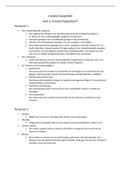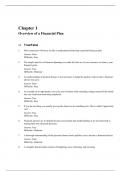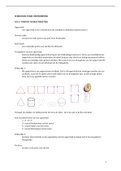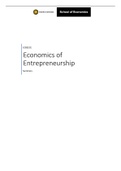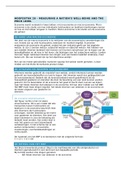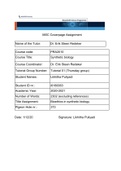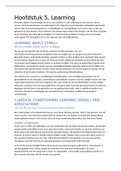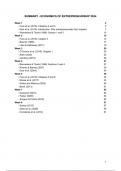Attachment + Psychopathology
, Attachment Caregiver - infant interactions
Reciprocity + Interactional synchrony 1. - is difficulty inferring developmental importance.
Early interactions are meaningful - quality of interactions is Feldman points that synchrony simply described behaviours that occur
at the same time. These are robust phenomena in the sense that they
associated with successful development of attachments. can be reliably observed, but this may not be useful as it does not tell us
their purpose. This means that we cannot be certain from observations
Reciprocity - baby + caregiver respond to and elicit responses from that reciprocity or synchrony are important in development.
each other HW - some evidence from other sources (Isabella et al) suggests that good levels
Mothers successfully respond around ⅔ of the time - Feldman + of reciprocity + synchrony are associated with good quality attachments.
Eidelman 2. + use of filmed observations
Around 3 months - interactions more intense + reciprocal Filmed from multiple angels. Very fine details of behaviour can be
Babies are active ppts and can initiate interactions recorded + analysed later. Also, babies do not know that they are getting
observed, so their behaviour does not change in response to
Interactional Synchrony - ‘ the temporal coordination of micro - observations. The studies have good reliability + validity.
HW - difficult to observe the actual babies’ behaviour
level social behaviour’ caregiver + baby mirror each other’s Babies are not very coordinated we just observe small gestures + small changes in
behaviours expression. So, it is hard to interpret the meaning o the babies’ movements ( is
Meltzoff + Moore - observed the beginnings of IS in babies as the hand movement a response or is it just a twitch). This means that we cannot
young as 2 weeks. Adult displayed ⅓ facial expressions and filmed be certain that any particular interactions observed between baby + caregiver are
the baby’s responses. Babies expression and gestures were more meaningful.
likely to mirror those of the adults than chance would predict. 3. + has allowed caregiver - infant attachment improve - good practical
value
Isabella et al - observed 30 mothers + babies together. They found It has allowed psychologists to improve the quality of attachment or
high level of synchrony were associated with better quality mother example, parent child interaction therapy.
- baby attachment. (e.g. the emotional intensity of the HW - this kind of research is socially sensitive because it can be used to argue
that mothers should focus just on interacting with their baby and not return to
relationships). work. This means that the practical value may be outweighed by its negative
social consequences.
, Schaffer’s stages of attachment
1. Asocial stage (first few weeks)
: 1. + Schaffer + Emerson’s study had high external validity.
- baby’s behaviour towards Most of the observations were made by parents during ordinary
people and inanimate objects Schaffer + Emerson study
activities + reported it to researchers. The alternative would have to
are the same. - 60 babies from Glasgow - most
be the researchers observe the babies behaviour in the house. This
- Some preference to familiar working class families
- Researchers visited babies + mothers may have distracted the babies or made them feel anxious. So, this
people.
at home every month for a year and means that the ppts probably did behaviour naturally.
- Babies happier in the presence
of other people. then again at 18 months CP - mothers may have been biased in what they reported (baby might have
2. Indiscriminate attachment - Separation anxiety measured - shown signs of anxiety but they didn’t report it)
(2-7 months): asking mums about child’s behaviour This means that even if the babies behaved naturally their behaviour may
- More observable social during everyday separation not have been accurately recorded.
behaviour. Preferences for - Stranger anxiety - asking mums
people over objects. questions about child’s response to
2. + the study was carried out in a large scale study in Glasgow and
- No stranger or separation unfamiliar adults
focused in a single stage
anxiety shown. HW - Child rearing practices vary considerably according to cultural +
- Attachment is indiscriminate Babies formed attachments through sequences
of stages historical context. (Van Ijzendoorn - multiple attachments in a collectivist
as it is the same towards all.
3. Specific attachment (7 The specific attachment was made with the culture is seen as normal) This means that we cannot generalise the
months): person who was most interactive + sensitive to observations from this study to other populations.
- Stranger and separation the baby's signals and facial expressions.
anxiety shown when taken (reciprocity) 3. - Poor evidence for the asocial stage.
away from a particular person. Young babies have poor coordination and are fairly immobile This
- Specific attachment made with makes it difficult for mothers to accurately report signs of anxiety
the primary figure + attachment for this age group. This means that the babies could
- 65% its the mother - most be quite social but because of flawed methods they appear asocial.
interactions and responds to
HW - there is real world application to day care.
baby’s signals.
4. Multiple attachment (by one
Early stages babies can be comforted by any skilled adult. But, if a child
year): starts daycare later, during the stage of specific attachments care from an
- Secondary attachments with unfamiliar adult may cause distress + long term problems. This means that
other adults made Schaffer + Emerson’s stages can help parents make day care decisions.
- 29% of babies in the study had
secondary attachments within
a month.

